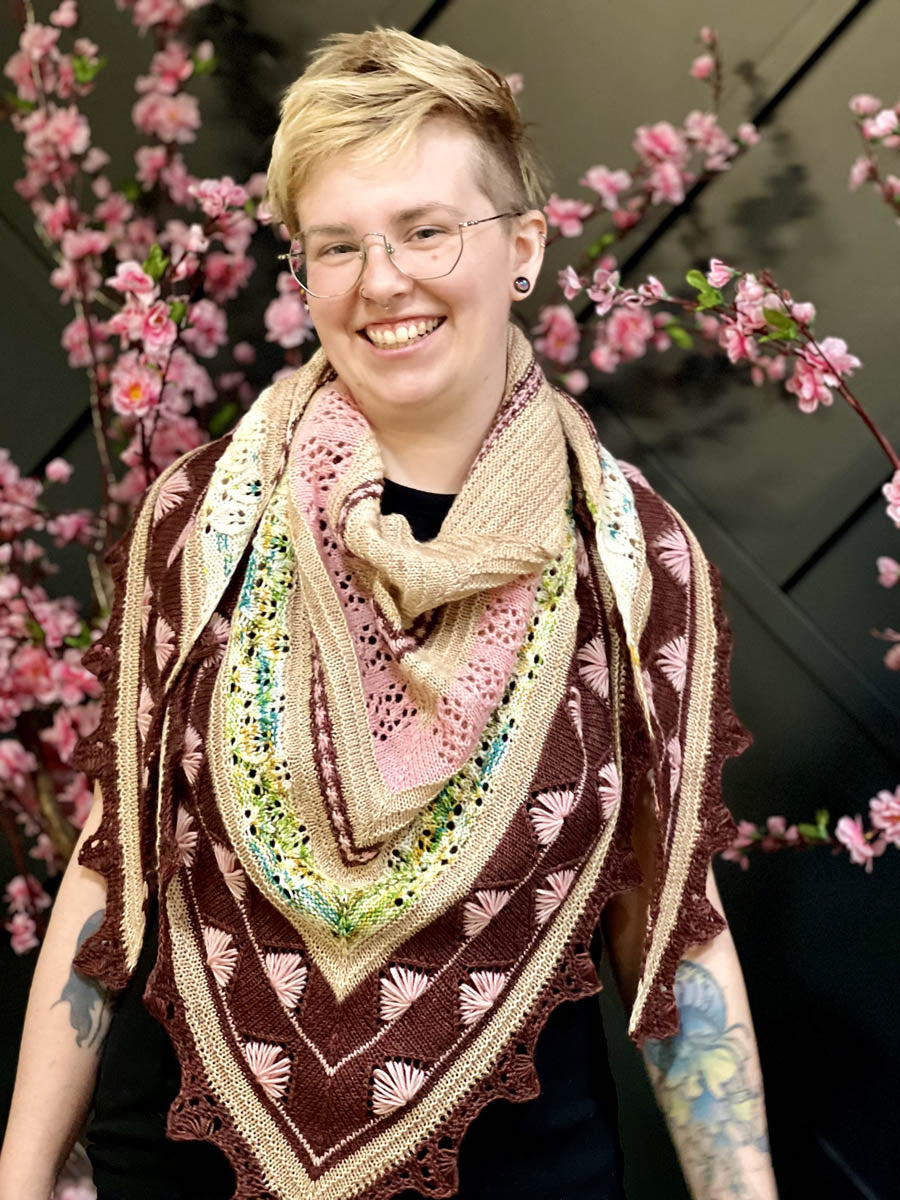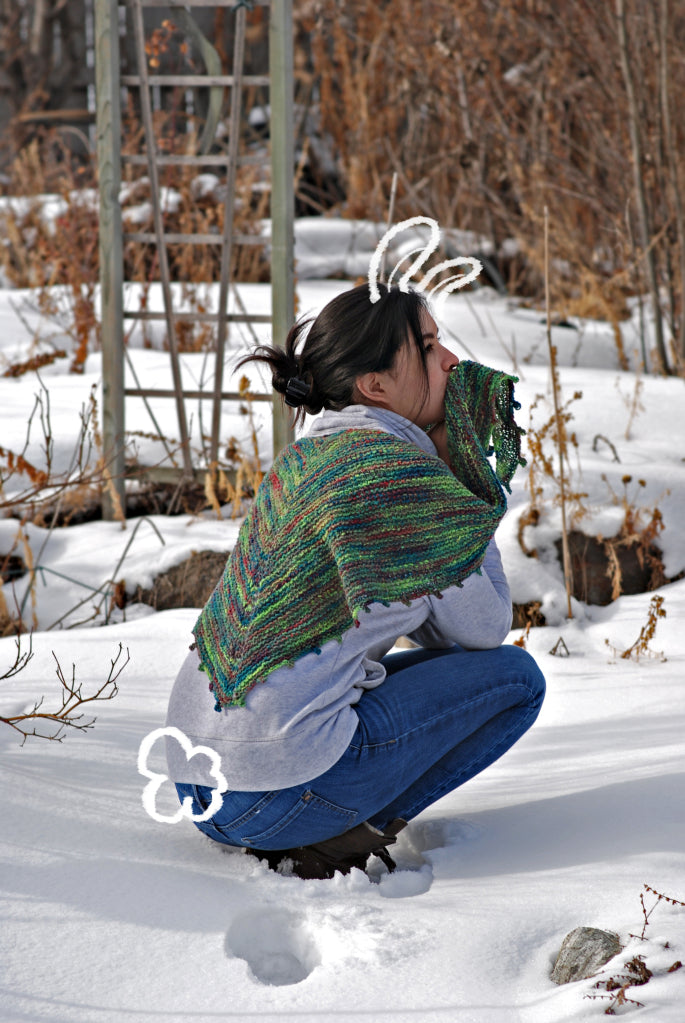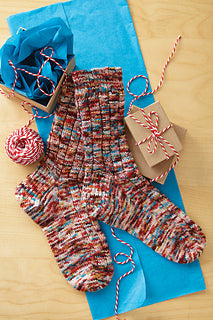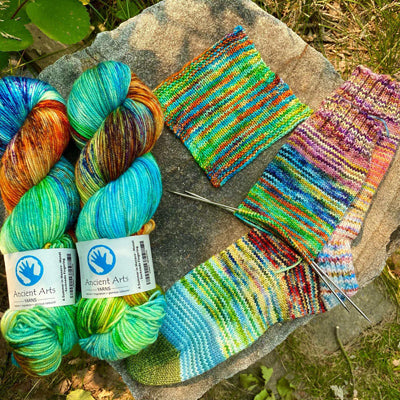Throughout the course of my long and varied knitting career I have many times wondered how yarn companies choose the yarns they choose. Why this colour? Why that fiber? Why this fiber blend and not that one? What are all these types of wool? It wasn’t until I started to spin my own yarns back in 1997 that I began to find the answers for myself. And what a world of research that opened up!
Nearly 20 years of this yarn research has taught me that good yarns don’t come about by chance. They are the product of decades of experience and knowledge, and ideally should have a very specific purpose in mind when they are designed. Yarn is not all created equal, with each variety being best used for certain things. We have all at one time or another knitted (or crocheted) something that just didn’t work, and chances are it was due in part to the yarn we used not being right for the end purpose.
In my case the aha moment about choosing the right yarn for the right purpose came about thanks to the infamous (in my family) giant orange sweater I knit when I was 18. With the great sunflower disaster of ’83 as that sweater came to be known, I learned that garments with big bold sunflowers made with projecting bobbles situated right on the center of the chest should not be knit in super chunky soft spun yarn. No matter what size you knit (and I grimly tried them all as I reknit this poor thing three times in my efforts to make it work) the sweater will sag past your knees. Even worse, it will give you a chest that, well, um, isn’t as flattering as you might like. My father’s scandalized comment when I tried it on said it all. “Good lord it’s the Great Pumpkin and what IS that on your chest??? You can’t go out looking like that!” Thanks Dad. If I had chosen a different yarn (and colour) for this sweater it would no doubt have been far less horrific. More twist and more plies to the yarn (and a finer gauge) would have prevented the sag, and meant the sunflower was as demure as it should have been. It wasn’t the fault of the yarn – I simply chose the wrong yarn for the project. It’s all a matter of looking at the character of the yarn and figuring out what it is best suited to do.
Throughout my many years of spinning I learned to create yarns that would do what I wanted them to do. I learned that the amount of twist in the yarn, the number of plies (strands) in the yarn, the materials it was made from, all come together to make yarn do certain things. Tighter twisted yarns are stronger but less soft. More plies makes for a rounder yarn that will wear longer than fewer plies. So how does this work in practice? Let’s look at two examples. Lace weight yarns are better made with two plies of yarn, with fibres that are not too fluffy. Two plies allow lace patterns to open up and show themselves clearly, whereas a three ply (or more) yarn will not open out as much and thus the pattern is not quite as distinct. Wool that is too fluffy makes those patterns hard to see, so choosing materials with a certain fineness that isn’t TOO fine (i.e. a longer staple wool) or with lots of drape (e.g. add some silk) makes the yarn work better for knitting lace, because you can better see the lace patterns and they stay crisp. Sock yarn needs to be strong so it needs to have lots of twist (which keeps the fibres together and helps prevent them getting broken) and should be made from sturdy materials with more plies than lace yarns so that the socks last for years. More than two plies mean the stitches have good definition and the yarn is stronger too. Soft, two ply low twist sock yarn means the socks wear out quickly. Fluffy merino socks are lovely and warm, but can wear out in a week with hard wear. The same yarn is delightful in a cowl where it will not get the same level of wear, and instead it can do its job keeping one’s neck nice and warm.


Wool is very important to yarn. Did you know that sheep are not all the same when it comes to their wool?There are over 100 breeds of sheep, all with their own wool characteristics that make their wool suitable for all sorts of different types of yarns. Fine wool sheep like merino produce the softest fluffiest wool that is good for soft garments that one can wear next to the skin. Long wool and crossbred sheep like Blue Faced Leicester, Romney, Wenslydale (sheep can have the best names!) or Gotland sheep produce wool that is stronger, coarser, not fluffy, with more drape and less bounce, and make great strong garments like socks and outer sweaters. Down wool sheep like Suffolk or Montadale are raised mostly for meat but also grow very bouncy elastic wool great for items like blankets. Primitive wool sheep like Shetland or Icelandic sheep are often double coated, ranging from super fine to very coarse, and thus can be used for many types of yarn including the perfect woolen yarn for fair isle knitting or big fat Lopi type yarns. The wool in your yarn is very important as it will make all the difference in how the yarn performs in a garment.

Yarn of course can also be made from many other fibres. Natural fibres like silk add drape, softness and shine, strength (silk is VERY strong) as well as interesting thermal properties (warm in cool weather and cool in warm weather). Alpaca adds drape and softness, but needs plenty of twist to hold together properly. Mohair (which comes from goats) adds strength, luster, drape, and depending on its fineness softness, plus it takes dye in spectacular jewel tone fashion. Not to mention it has a fabulous halo! Down fibres (the undercoat of the animal) like cashmere, bison down, or yak add super amounts of warmth and softness. Manmade fibres like nylon or polyester add strength and a touch of elasticity. Blending these fibres with wool can give you the best of all worlds as you can put together a yarn with just the characteristics you want! A yarn is only as good as its materials though, so you want to get the best quality fibers you possibly can.

Owning a yarn company is the perfect place to put all this knowledge of yarn to work. We are very picky with the yarns we offer through Ancient Arts as we want the design of each yarn to be the best for each end purpose. So let’s take a look at a few of our yarns to see how the design affects what they are best used for.
If we compare two of our fingering weight yarns, 100% merino wool, and 100% Blue faced Leicester (BFL) wool, we will find that these two yarns will perform differently as they are made from different types of wool. The merino wool yarn will make a lovely sweater or scarf, and will be delightfully soft and warm, but will wear out relatively faster as compared to a yarn with nylon if made into socks. Merino is fine and fluffy and thus holds lots of warmth but isn’t as strong on its own as it is so fine.

BFL wool is a luster long wool and therefore is coarser than merino. It is stronger, and has more drape, so it makes fabulous longer wearing socks or mittens, and gorgeous shawls with excellent drape. It holds less air as the fibres are not as crimpy so it is great in warmer climates where merino might be too warm. These two yarns are on the surface the same yarn (fingering), but performance wise the different wools mean they are suited for different projects.


One of our brand new and coming soon yarns is an ideal candidate for understanding how and why blends are designed – a blend should provide the best of all worlds if done right. We are calling this yarn Reinvent, as it is made from fibres that are reclaimed from the milling process. Large mill machines need a lot of fibre to prime them, and much of this is left on the machines once a yarn is spun. This fibre is usually discarded, but we have worked with a mill to salvage it and blend it into a fantastic multipurpose yarn! Reinvent is a blend of 49% wool (mostly merino), 34% mohair, 11% nylon, 4% acrylic, and 2% silk. It is a fingering weight yarn with four plies. So what does all that do for this yarn? The wool component makes the yarn hold air which in turn makes it warm and soft with some bounce. This means this yarn would make a nice sweater, scarf, cowl, or warm shawl. The mohair adds strength, shine, makes the handle silky smooth, and gives it a bit of a halo. A shawl in this yarn with this halo would be lovely! Nylon adds strength and durability, meaning this yarn can work well in socks. The acrylic adds a touch more softness, and the silk adds strength and shine. The four ply structure means this yarn is nice and round and will have excellent stitch definition, plus the extra ply adds strength as the fibres are well twisted together and thus less likely to pill or wear out. Reinvent is the perfect example of blended fibres working together to make a yarn that suits many purposes. And it doesn’t hurt that thanks to its components it takes dye like a champion!
















Leave a comment (all fields required)